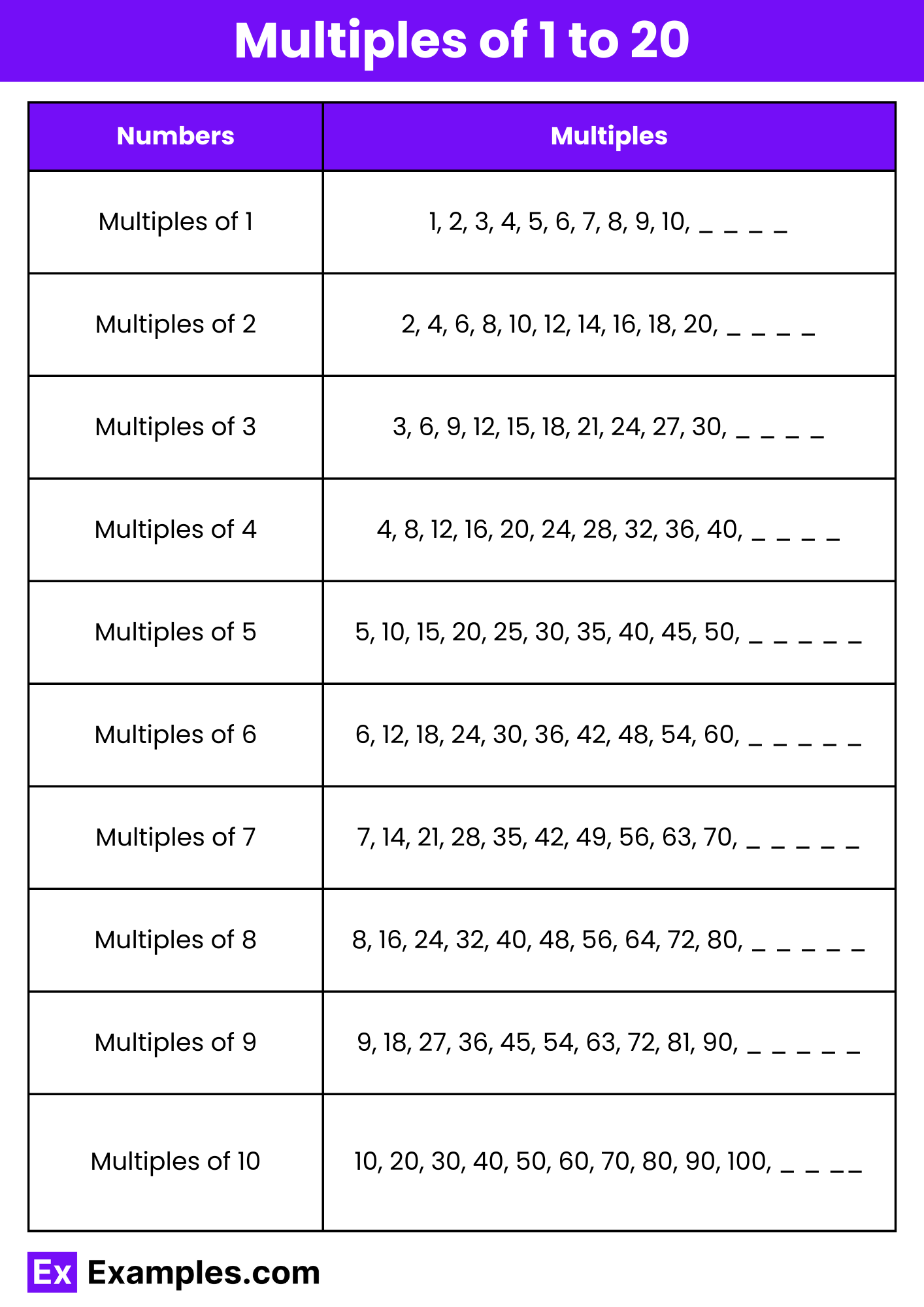Which of the following is a multiple of 4?
9
12
18
22


Multiples form a fundamental concept in mathematics, playing a crucial role in various areas such as arithmetic, algebra, and number theory. The multiples of a number are the products obtained when that number is multiplied by integers. For instance, the multiples of 3 include 3, 6, 9, 12, and so forth. In this context, understanding the multiples of numbers from 1 to 20 is essential, as these form the building blocks for more complex mathematical operations and problem-solving. By studying the multiples of 1 to 20, learners gain insight into patterns, divisibility, and the relationships between numbers, which are critical for mastering higher-level mathematics. This exploration provides a foundation for recognizing sequences, identifying common multiples, and applying these concepts in real-world scenarios such as scheduling, coding, and financial calculations.
Download Multiples of 1 to 20 in PDF

Download Multiples of 1 to 20 in PDF
| Numbers | Multiples |
|---|---|
| Multiples of 1 | 1, 2, 3, 4, 5, 6, 7, 8, 9, 10, _ _ _ _ _ |
| Multiples of 2 | 2, 4, 6, 8, 10, 12, 14, 16, 18, 20, _ _ _ _ _ |
| Multiples of 3 | 3, 6, 9, 12, 15, 18, 21, 24, 27, 30, _ _ _ _ _ |
| Multiples of 4 | 4, 8, 12, 16, 20, 24, 28, 32, 36, 40, _ _ _ _ _ |
| Multiples of 5 | 5, 10, 15, 20, 25, 30, 35, 40, 45, 50, _ _ _ _ _ |
| Multiples of 6 | 6, 12, 18, 24, 30, 36, 42, 48, 54, 60, _ _ _ _ _ |
| Multiples of 7 | 7, 14, 21, 28, 35, 42, 49, 56, 63, 70, _ _ _ _ _ |
| Multiples of 8 | 8, 16, 24, 32, 40, 48, 56, 64, 72, 80, _ _ _ _ _ |
| Multiples of 9 | 9, 18, 27, 36, 45, 54, 63, 72, 81, 90, _ _ _ _ _ |
| Multiples of 10 | 10, 20, 30, 40, 50, 60, 70, 80, 90, 100, _ _ _ _ _ |
| Multiples of 11 | 11, 22, 33, 44, 55, 66, 77, 88, 99, 110, _ _ _ _ _ |
| Multiples of 12 | 12, 24, 36, 48, 60, 72, 84, 96, 108, 120, _ _ _ _ _ |
| Multiples of 13 | 13, 26, 39, 52, 65, 78, 91, 104, 117, 130, _ _ _ _ _ |
| Multiples of 14 | 14, 28, 42, 56, 70, 84, 98, 112, 126, 140, _ _ _ _ _ |
| Multiples of 15 | 15, 30, 45, 60, 75, 90, 105, 120, 135, 150, _ _ _ _ _ |
| Multiples of 16 | 16, 32, 48, 64, 80, 96, 112, 128, 144, 160, _ _ _ _ _ |
| Multiples of 17 | 17, 34, 51, 68, 85, 102, 119, 136, 153, 170, _ _ _ _ _ |
| Multiples of 18 | 18, 36, 54, 72, 90, 108, 126, 144, 162, 180, _ _ _ _ _ |
| Multiples of 19 | 19, 38, 57, 76, 95, 114, 133, 152, 171, 190, _ _ _ _ _ |
| Multiples of 20 | 20, 40, 60, 80, 100, 120, 140, 160, 180, 200, _ _ _ _ _ |
The multiples of numbers from 1 to 20 illustrate fundamental principles of arithmetic and provide a foundational understanding of multiplication and divisibility. Each number within this range generates a unique set of multiples, starting from itself and extending infinitely as it is multiplied by increasing integers. For instance, the multiples of 1 are all natural numbers, while the multiples of 20 include 20, 40, 60, and so on. These multiples help identify common factors, least common multiples, and simplify complex mathematical problems. Understanding the multiples of numbers 1 to 20 is critical for mastering basic math concepts, which are essential for advanced studies in mathematics and its applications in science, engineering, and everyday problem-solving.
Text prompt
Add Tone
10 Examples of Public speaking
20 Examples of Gas lighting
Which of the following is a multiple of 4?
9
12
18
22
What is the smallest multiple of 7 greater than 20?
21
28
35
42
Which number is a multiple of both 6 and 9?
12
24
36
48
What is the sum of the first two multiples of 8?
8
12
16
24
What is the third multiple of 12?
24
36
48
60
. What is the smallest multiple of 13 that is greater than 39?
52
65
78
91
What is the smallest multiple of 15 that is greater than 30?
45
60
75
90
Which number is a multiple of 18 and also between 50 and 100?
54
60
72
90
How many multiples of 20 are there between 50 and 150?
4
5
6
7
What is the largest multiple of 15 less than 100?
75
90
60
105
Before you leave, take our quick quiz to enhance your learning!

